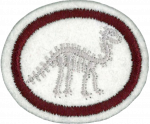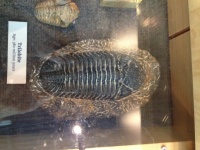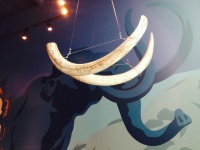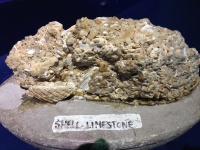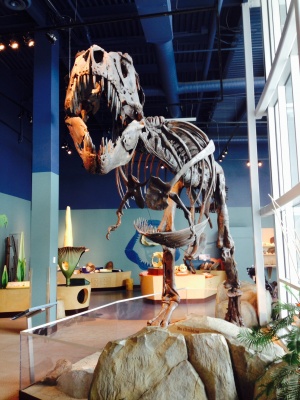AY Honors/Fossils/Answer Key 2/es
| Fósiles | ||
|---|---|---|
| División Norteamericana
|
Destreza: 2 Año de introducción: 1944 |
|
Requisitos
|
La especialidad de Fósiles es un componente de la Maestría Conservación. |
| Conexión Logros para la Investidura: Esta especialidad está relacionada con los requisitos de Logros para la Investidura para EXPLORADOR Estudio de la naturaleza que requiere estudiar artículos que complementan esta especialidad. Esta especialidad es una elección popular para la especialidad de la categoría de Estudio de la naturaleza de nivel de destreza 2 o 3 requerido para los EXPLORADORES DE CAMPO Y BOSQUE. |
1
Fossils are found in many places where sedimentary rocks, such as claystones, shales, limestones, and sandstones, are exposed. Only certain sedimentary rocks harbored the appropriate environmental conditions to preserve and yield fossils, which are often concentrated along particular bedding planes within the rocks.
Finding Fossils
Fossils are generally found in sedimentary rock with differentiated strata representing a succession of deposited material.
2
2a
2b
2c
2d
2e
A Graptolite is a fossil colonial animal known chiefly from the Upper Cambrian through the Lower Carboniferous (Mississippian) periods.
2f
2g
A dinosaur is any of various extinct reptiles.
2h
2i
Mastodons are members of the extinct genus Mammut of the order Proboscidea and form the family Mammutidae=== they resembled, but were distinct from, the woolly mammoth which belongs to the family Elephantidae. Mastodons were browsers and mammoths were grazers.
2j
Crinoids, also known as "sea lilies" or "feather-stars", are marine animals that make up the class Crinoidea of the echinoderms (phylum Echinodermata). There are only a few hundred known modern forms, but crinoids were much more numerous both in species and numbers in the past. Some thick limestone beds dating to the mid- to late-Paleozoic are entirely made up of disarticulated crinoid fragments.
2k
Lingula is a genus of brachiopods.
2l
A fossil made when sediment filled the hollow stem of a plant.
2m
The Foraminifera are a large group of unicellular organisms with reticulating pseudopods, fine strands of cytoplasm that branch and merge to form a dynamic net. They typically produce a test, or shell, which can have either one or multiple chambers, some becoming quite elaborate in structure. About 275,000 species are recognized, both living and fossil.
2n
Radiolaria are amoeboid protozoa that produce intricate mineral skeletons, typically with a central capsule dividing the cell into inner and outer portions, called endoplasm and ectoplasm. They are found as zooplankton throughout the ocean, and because of their rapid turn-over of species, their tests are important diagnostic fossils found from the Cambrian onwards.
2o
The Paleozoic Era is the earliest of three geologic eras of the Phanerozoic eon. The Paleozoic era is defined by evolutionary geologists as spanning from roughly 542 million years ago to roughly 251 million years ago.
| Phanerozoic eon | ||
|---|---|---|
| Paleozoic era | Mesozoic era | Cenozoic era |
2p
Lying between the Paleozoic and the Cenozoic, Mesozoic means 'middle animals'. It is often called the 'Age of the Dinosaurs'.
2q
The Cenozoic Era is the latest of three geologic eras of the Phanerozoic eon. Evolutionary geologists define this era as having started about 65 million years ago, when the age of the dinosaurs ended.
2r
The Pleistocene epoch on the evolutionary geologic timescale is the period from 1,808,000 to 11,550 years before present. The Pleistocene epoch had been intended to cover the world's recent period of repeated glaciations, or the Ice Age.
2s
Paleobotany is the branch of paleontology or paleobiology dealing with the recovery and identification of plant remains from geological contexts, and their use for the biological reconstruction of past environments. Paleobotany includes the study of terrestrial plant fossils, as well as the study of prehistoric marine photoautotrophs, such as photosynthetic algae, seaweeds or kelp.
2t
Pelecypod are molluscs belonging to the class Bivalvia. They typically have two-part shells, with both valves being symmetrical along the hinge line. The class has 30,000 species, including scallops, clams, oysters and mussels.
2u
Brachiopods are two-shelled marine animals with an external morphology superficially resembling pelecypods (for instance, clams) of phylum Mollusca to which they are not closely related. It is estimated by paleobiologists that 99 percent of all documented lamp-shell species are both fossils and extinct.
3
Most museums of natural history will have a fossil collection, and even small museums are likely to have a few. If you do not know of such a museum in your area, the Internet is your friend. Try searching for "fossil," "museum," and the name of your locality. If you are still unsure, get a list of local museums and call them. They will be happy to tell you if they have fossils on display, and if they do not, they may be able to direct you to a museum that does. Also not all museums are called a museum. The T Rex and some other fossils shown here were photographed at Science World in Vancouver. After the visit, have your Pathfinders either write their reports or present one orally. This would be a great topic for worship during your club's opening exercises, or during a campout.
4
Removal of delicate specimens
For extracting fossils from harder rocks, a sturdy mallet and cold steel chisels may also be required. Usually one needs a range of chisels in size from small ones with a sharp edge of about 1 cm (quarter of an inch), to much larger and heavier chisels. A broad-bladed chisel is often very useful for splitting rocks along their bedding plane.
Different types of rocks will break differently and a beginner should put in a little practice, getting the feel for a particular type of rock before he or she starts hammering out fossils. It is all too easy to ruin a specimen with one ill-placed blow of a hammer.
Extracting a specimen that is embedded in solid rock may prove to be a long and difficult process. Before attempting to extract a specimen, the collector should make sure that it is feasible to remove it without destroying or damaging it. Leaving sufficient rock beneath the specimen to protect it from fracturing; excess matrix can be trimmed at a later time.
For soft sediments and unconsolidated deposits, such as sands, silts and clays, a spade and a flat-bladed trowel or stout bladed knife may be the most useful tools for clearing the area around a fossil. Brushes are also useful for removing loose sediment from around fossils.
A sieve is used to separate fossils from sands and gravels. A smaller mesh is required in order to avoid losing small fossils. One practical difficulty with using sieves in the field is that they easily become clogged, especially when the material sieved has a high moisture content. However, under dry weather conditions the more durable fossils, such as teeth and bones, can be quickly and easily sieved out of loose sands. Shaking the sieve is always liable to damage or destroy fragile fossils.
If there is water available, such as on a beach or next to a stream, the material containing the fossils can be sieved wet and the matrix gradually washed away. Wet sieving is a technique that is frequently used for the collection of small mammalian fossils, and by using this technique even the smallest specimens may be recovered.
Removing gigantic fossils
Occasionally, large fragile specimens may need to be surrounded and supported using a jacket of plaster before their removal from the rock: This protects the fossil, protecting it from shattering. If a fossil is to be left in situ, a cast may be produced, using plaster of paris or latex - while not preserving every detail, such a cast is inexpensive, easier to transport, causes less damage to the environment, and leaves the fossil in place for others to enjoy. Subtle fossils which are preserved solely as impressions in sandy layers, such as the Ediacaran fossils, are usually sampled by means of a cast, which shows up detail more clearly than the rock itself.
Valuable fossils
If you find an obviously valuable fossil, you should contact a professional. It is too easy to ruin a fossil by attempting to remove it yourself. Leave the extraction in the hands of an experienced collector. If you find such a fossil on public land, contact the authority responsible for the land. The fossil belongs to them, and they have the right to decide what to do with it. To find a professional, contact a museum or a local university. If they do not have one on staff, they will be able to refer you to one.
5
Evolutionists and creationists both agree that fossils are formed when a creature is quickly buried in sediment. They disagree on how long ago this happened. Evolutionists believe most fossils were made millions of years ago. Creationists believe that nearly all fossils were made during Noah's flood less than 10,000 years ago.
6
- a. Carbón
- b. Petróleo
- c. Fósiles
- d. Caliza
| De Historia de Patriarcas y Profetas, p. 98, 99 |
|---|
| Por doquiera yacían cadáveres de hombres y animales. El Señor no iba a permitir que permaneciesen allí para infectar el aire por su descomposición, y por lo tanto, hizo de la tierra un vasto cementerio. Un viento violento enviado para secar las aguas, las agitó con gran fuerza, de modo que en algunos casos derribaron las cumbres de las montañas y amontonaron árboles, rocas y tierra sobre los cadáveres.
En ese tiempo inmensos bosques fueron sepultados. Desde entonces se han transformado en el carbón de piedra de las extensas capas de hulla que existen hoy día, y han producido también enormes cantidades de petróleo. Con frecuencia la hulla y el petróleo se encienden y arden bajo la superficie de la tierra. Esto calienta las rocas, quema la piedra caliza, y derrite el hierro. |
Referencias
- Categoría: Tiene imagen de insignia
- Adventist Youth Honors Answer Book/Honors/es
- Adventist Youth Honors Answer Book/es
- Adventist Youth Honors Answer Book/Skill Level 2/es
- Categoría: Libro de respuestas de especialidades JA/Especialidades introducidas en 1944
- Adventist Youth Honors Answer Book/North American Division/es
- Adventist Youth Honors Answer Book/Unknown/es
- Adventist Youth Honors Answer Book/Unknown/Primary/es
- Adventist Youth Honors Answer Book/Stage 0/es
- Adventist Youth Honors Answer Book/Conservation Master Award/es
- Adventist Youth Honors Answer Book/IAConnection/es
